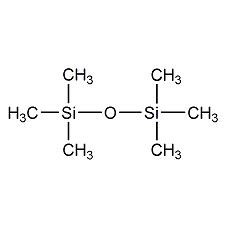
Structural formula
| Business number | 02VB |
|---|---|
| Molecular formula | C6H18OSi2 |
| Molecular weight | 162.28 |
| label |
water repellent, gas chromatography stationary solution, Ether and acetal solvents |
Numbering system
CAS number:107-46-0
MDL number:MFCD00008265
EINECS number:203-492-7
RTECS number:JM9237000
BRN number:1736258
PubChem number:24852329
Physical property data
1. Properties: Colorless and transparent liquid, easy to deliquesce. [1]
2. Melting point (℃): -59[2]
3. Boiling point (℃): 99.5[3]
4. Relative density (water=1): 0.764 (25℃)[4]
5. Relative vapor density (air = 1): 5.5[5]
6. Saturated vapor pressure (kPa): 5.6 (25℃)[6]
7. Critical pressure (MPa): 1.91[7]
8. Octanol/water partition coefficient: 4.2[ 8]
9. Flash point (℃): -2[9]
10. Ignition temperature (℃): 341 [10]
11. Explosion upper limit (%): 32[11]
12. Explosion lower limit (%) : 0.6[12]
13. Solubility: Insoluble in water, soluble in most organic solvents. [13]
Toxicological data
1. Skin/eye irritation
Standard Draize test: rabbit, skin contact: 500mg/24H, severity of reaction: mild.
2. Acute toxicity: Rat oral LDLo: 3mL/kg; mouse abdominal LD50: 4500mg/kg; rabbit skin contact LD50: 16mL/kg; guinea pig oral LDLo: 50mg/kg ;
3. Irritating to eyes, respiratory system and skin.
4. Acute toxicity[14]
LD50: 4500mg/kg (mouse Abdominal cavity); 16ml (12224mg)/kg (rabbit transdermal)
LC50: 15956ppm (rat inhalation, 4h)
5. Irritation[15]
Rabbit transdermal: 500mg (24h), mild stimulation.
Rabbit eye: 100μl (24h), mild irritation.
Ecological data
1. Ecotoxicity No data available
2. Biodegradability No data available
3 .Non-biodegradability[16] In the air, when the concentration of hydroxyl radicals is 5.00×105/cm3, the degradation half-life is 12d (theoretical).
Molecular structure data
1. Molar refractive index: 49.02
2. Molar volume (cm3/mol): 205.4
3. Isotonic specific volume (90.2K ): 408.8
4. Surface tension (dyne/cm): 15.6
5. Polarizability: 19.43
Compute chemical data
1. Reference value for hydrophobic parameter calculation (XlogP): None
2. Number of hydrogen bond donors: 0
3. Number of hydrogen bond acceptors: 1
4. Number of rotatable chemical bonds: 2
5. Number of tautomers: None
6. Topological molecule polar surface area 9.2
7. Number of heavy atoms: 9
8. Surface charge: 0
9. Complexity: 76.2
10. Number of isotope atoms: 0
11. Number of determined atomic stereocenters: 0
12. Number of uncertain atomic stereocenters: 0
p>
13. Determine the number of stereocenters of chemical bonds: 0
14. Uncertain number of stereocenters of chemical bonds: 0
15. Number of covalent bond units: 1
Properties and stability
1. Stability[17] Stable
2. Incompatible substances [18] Strong acids, strong bases, strong oxidants, water and water vapor
3. Conditions to avoid contact[19] Humid air
4. Polymerization hazard[20] No polymerization
5. Decomposition products[21] Silicon oxide
Storage method
Storage Precautions[22] Store in a cool, dry and well-ventilated non-combustible warehouse. Keep away from fire and heat sources. The storage temperature should not exceed 37°C. The packaging must be sealed and must not come into contact with air. They should be stored separately from oxidants, acids, alkalis, etc. and avoid mixed storage. Use explosion-proof lighting and ventilation facilities. It is prohibited to use mechanical equipment and tools that are prone to sparks. The storage area should be equipped with emergency release equipment and suitable containment materials.
Synthesis method
1. Add 62.49g (0.575mol) trimethylchlorosilane dropwise into a solution composed of 72.7g (0.06mol) N,N-dimethylaniline and 7g water, and heat to reflux for 1 hour. Distill under normal pressure, collect the 98-101°C fraction, and dry it to obtain hexamethyldisilyl ether, yielding 43-44g, with a yield of 92-94%. Industrial production is to hydrolyze trimethylsilyl chloride at 30-40°C.

Purpose
1. Used for circulating coolant in instruments and manufacturing various silicone products. It is also used as a hydrophobic agent for surface treatment of fiber fabrics and insulation and moisture-proofing of radio parts. Also used in gas chromatography stationary solutions.
2. Important silicone oil and silicone resin intermediates, also used as pharmaceutical raw materials.
3. Used as silicone oil, silicone rubber, pharmaceuticals, gas chromatography stationary solutions, analytical reagents, hydrophobic agents, etc. [23]

 微信扫一扫打赏
微信扫一扫打赏

